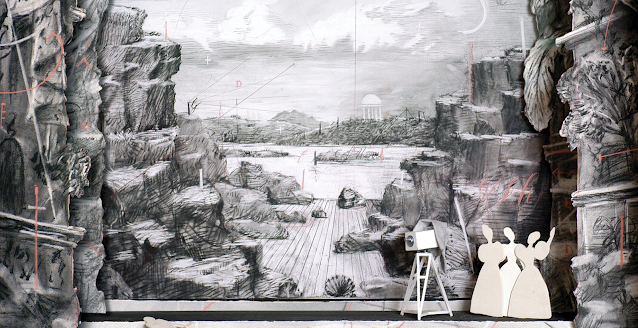Mozart – Die Zauberflöte
La Monnaie, Brussels, May 1 2005
Conductor: René Jacobs. Production: William Kentridge. Sarastro: Harry Peeters. Königin der Nacht: Ana Camelia Stefanescu. Tamino: Topi Lehtipuu. Pamina: Sophie Karthäuser. Papageno: Stephan Loges. Papagena: Céline Scheen. Monostatos: Jeffrey Thompson. Erste Dame: Salomé Haller. Zweite Dame: Isabelle Everarts de Velp. Dritte Dame: Angélique Noldus. Sprecher: Zelotes Edmund Toliver. Erster Geharnischter/Zweiter Priester: Lorenzo Caròla. Zweiter Geharnischter/Erster Priester: Marc Claesen.
Cute Flute
The word on people’s lips at the interval of this new Brussels Flute was not so much “beau” as “joli.” In English, “pretty” sounds pejorative, but “joli” is what it says, and this was a “joli spectacle” with some “jolies voix.” It was the kind of production Brussels does particularly well: a properly-rehearsed team effort by committed and mostly young performers. The cast was generally strong, except perhaps for Papageno’s slight bleat and a rather dull Monostatos. For once, our Sarastro, though not a cavernous bass, had all the notes, and the Queen of the Night, though apparently young for the part, found time to phrase and shape, not just tweet or shriek, and most of the notes were right. Papagena may not be much of a role, but Céline Scheen radiated gleeful charm. But I would really like to single out Pamina and Tamino. They were beautifully matched. Sophie Karthäuser’s voice is strong and sweet, and she acts well. She should do very well in Mozart and in the baroque.
And Topi Lehtipuu… OK, the name’s a bummer, but I’ve been keeping an eye on his career. This is what I wrote in my review of Rameau’s Les Paladins: “I'd like in particular to draw attention to the young Finnish tenor Topi Lehtipuu, who intrigued us all, as an unknown singer, last season with an outstanding performance of the brief sailor's song in the second part of Les Troyens. He has a very lyrical high tenor voice with the kind of agility and bite needed for this French declamatory style, and diction even better than most of those around him in this production. As his voice matures, we may have in him a tenor of the Alfredo Krauss kind, a Werther and a Faust. One to watch, definitely.” He sings intelligently, elegantly and musically, and you should seek out that song on the DVD of Les Troyens and give it a good listen.
Those who know Jacobs’ recording of Le Nozze will easily imagine the theatrical verve (and period sound effects) he brought to the score, how it zipped and bounced along, and what fun the fortepiano-player had. To me, this kind of approach makes more sense of Mozart than playing his operas as some kind of Brahmsian oratorio.
William Kentridge’s production played on the themes of black and white, positive and negative, including film and photography. The stage was like a blown-up toy theatre, with traditional flat sets “cut out” of picturesque, black and white wood engravings of Egypt. The characters were dressed as 1890s explorers and equipped with early cameras, and Tamino wore a safari suit and carried a rifle. Papageno resembled a quack. This picture-book setting was occasionally overlaid with monochrome projections of Masonic and Egyptian symbols and geometric diagrams, or, at the right moments, successive rows of temple columns., birds or flames. Sarastro was a kind of Masonic archaeology professor, and while he lectured, his disciples nursed wooden compasses and triangles and T-squares in their laps. When what the characters imagined or saw was projected like a Turkish Karagöz shadow play or an early silent film at the rear (accompanied, very convincingly, by the fortepiano), we realised that the stage itself was the inside of a box camera, the sets in the wings were like the bellows, and the screen at the rear was the lens looking out.
It was a clever production with a lot of charm. Joli, indeed. But it still did nothing to help me understand what people find so fascinating in Schikaneder’s series of non-sequiturs leading nowhere of interest…




Comments
Post a Comment